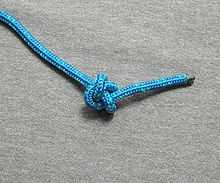Stopper knot
| Stopper knot | |
|---|---|
| Names | Stopper knot, Backup knot |
| Typical use | Keeps the line from slipping out of things. |
The term stopper knot (or simply stopper) has three distinct meanings in the context of knotting and cordage.
At the end of a line

A stopper knot is tied at the end of a rope to prevent the end from unraveling, slipping through another knot, or passing back through a hole, block, or belay/rappel device. Knots commonly used for this purpose are:
Around the standing part

When a stopper knot is tied outside another knot and around the standing part it can also be called a backup knot. Tying the end around the standing part helps prevent the knot from unraveling by not allowing the end to slide back into the knot. Examples of this usage are often seen in climbing, rope rescue, and other safety-of-life situations. Common knots used for this purpose are:
Nautical usage
In nautical settings, a stopper may refer to a length of rope that is belayed at one end with the other end attached to a tensioned line using a friction hitch in order to slacken a portion of the tensioned line. For example if a sheet becomes jammed on a winch while under sail, a "stopper" can be used to temporarily take the strain off the winch while the riding turn is cleared.
- Rolling hitch & similar friction hitches